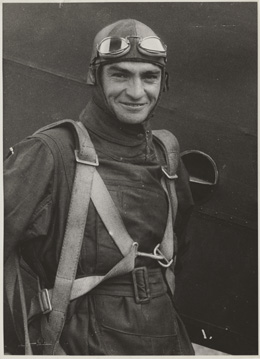On April 29, 1928, Spokane pioneer aviator Major John T. Fancher is fatally injured by a bomb explosion during an air show in East Wenatchee. "Jack" Fancher, as he is known, has flown out to Wenatchee with other members of his Spokane-based air national guard unit to take part in an air show at the East Wenatchee airfield, as part of Wenatchee's Apple Blossom Festival. He thrills the crowd during the illuminated night flight by demonstrating some aerial bombing techniques, which consist of throwing grenade-like bombs from the cockpit. After the demonstration, Fancher checks on three bombs which failed to explode. One blows up as he inspects it, blowing off one hand and severely damaging his eye and face. He is rushed to the hospital and dies a few hours later. Within days, the East Wenatchee airfield is named Fancher Field in his honor.
'What's the Matter with These Things?'
Fancher, a World War I pilot and the commander of Spokane’s air national guard unit, had already successfully completed the demonstration when the accident occurred. He had gone to a tent, changed into his uniform and gone back out to the plane. He was checking to see why three of the bombs had failed to go off.
“What’s the matter with these things? he said (“Explosion”).
The bombs were apparently designed to explode six seconds after the fuses were scratched with a special “scratcher.” He scratched one, threw it across a field and it exploded. The second failed to go off. The third exploded as soon as Fancher scratched it.
His right hand was blown off, his right eye gouged out and his body stripped bare and scorched above the waist.
“Well, boys, I’ve made my last flight and I’m glad it was a night flight, but I’ll still be able to handle a team on the farm, I guess,” he said in the car on the way to the hospital (“Explosion”). He died soon after of internal injuries.
'We Are Almost Speechless'
The accident deeply shook Wenatchee residents, many of whom were at the air show. Within two days, the Wenatchee Chamber of Commerce announced plans to name the field Fancher Field. Before that, it had been informally referred to as simply the Wenatchee or East Wenatchee airfield.
“We are almost speechless,” said a chamber official. "Major Fancher was an outstanding man in his field of work and was respected and loved by all who knew him. If it had not been for Fancher, we could not have had our airport available for the 1928 airport activities” (“Plan Memorials”).
Spokane mourned him as well. A subscription was immediately taken up to purchase and install a new beacon light for Spokane’s Felts Field, where Fancher’s unit was based, and call it the Fancher Memorial Beacon. In 1929, one of the roads approaching Felts Field was renamed Fancher Way.
Remembering Jack Fancher
Fancher’s stature in the region went beyond his flying abilities. He had been a star basketball player for the University of Washington. In 1926, he ran as a Republican for U.S. Congress in Eastern Washington, narrowly losing to the incumbent, Sam B. Hill.
His widow later sued the maker of the bomb and won a $26,000 settlement.
Today Fancher Way is a busy Spokane thoroughfare.
And even through Fancher Field in East Wenatchee was replaced a few decades later by Pangborn Memorial Airport several miles away, the name lives on at the site. Fancher Boulevard, Fancher Field Road, and Fancher Landing all run through the subdivision that now occupies the old airfield site, known as Fancher Heights.

